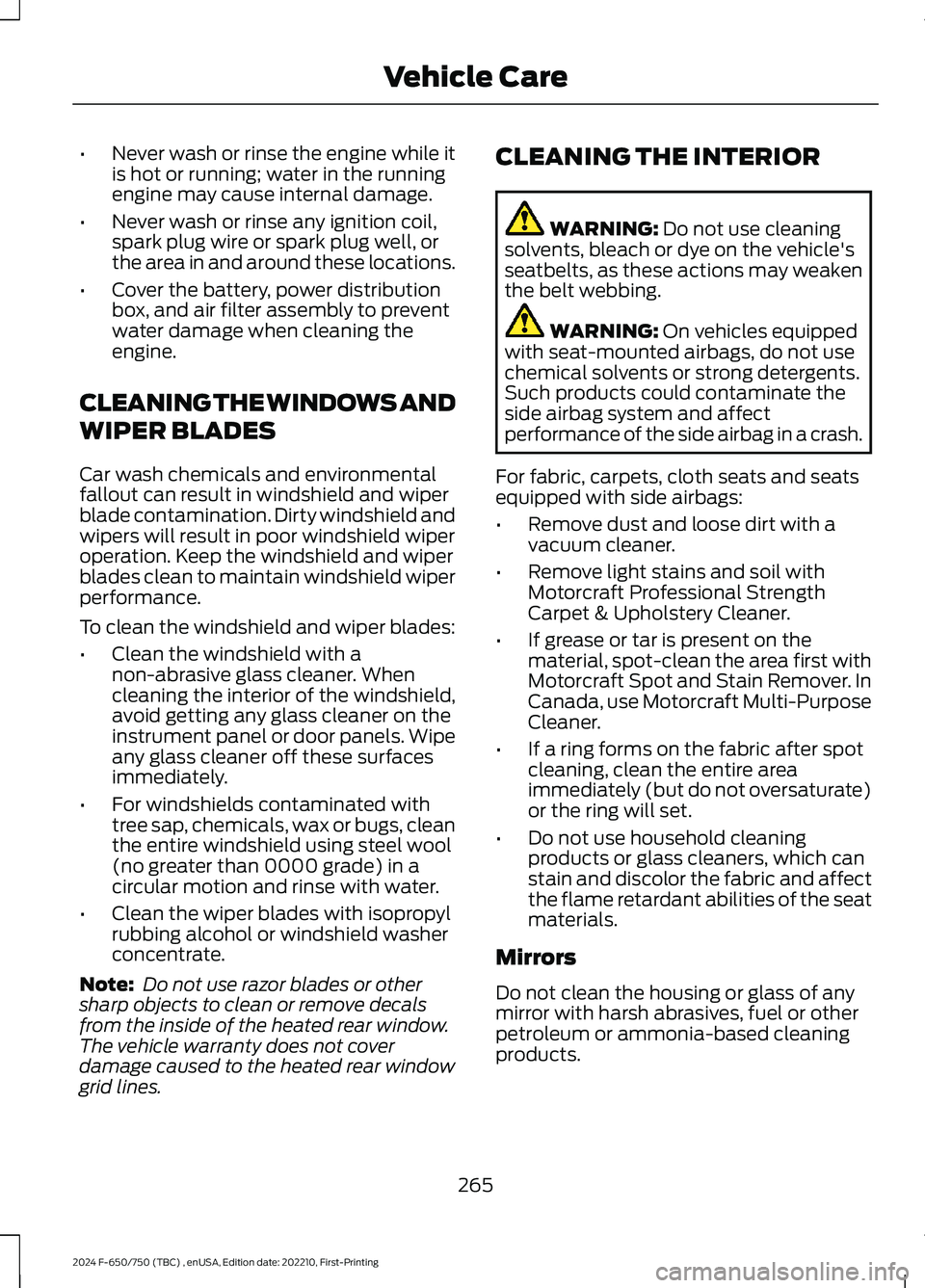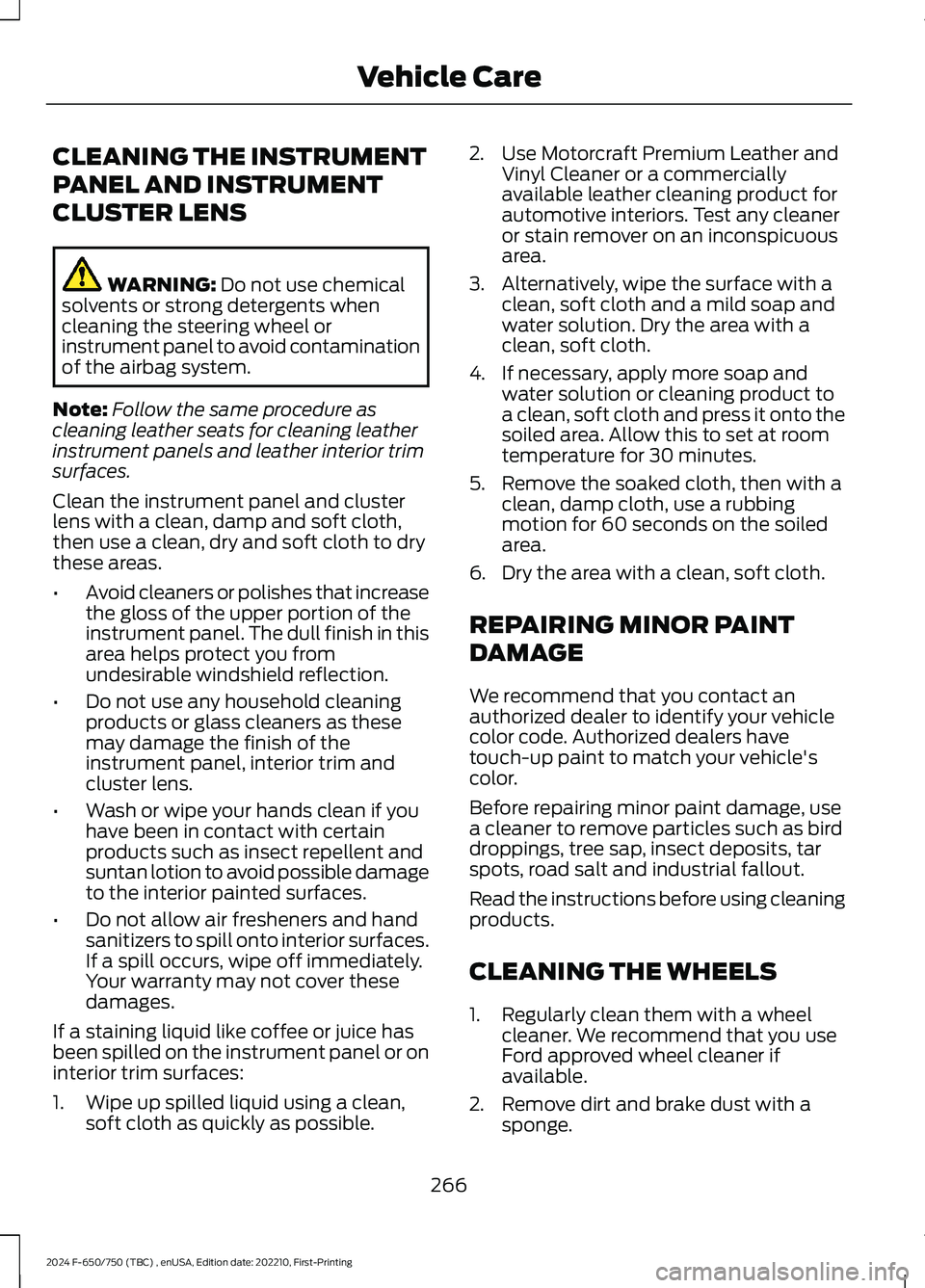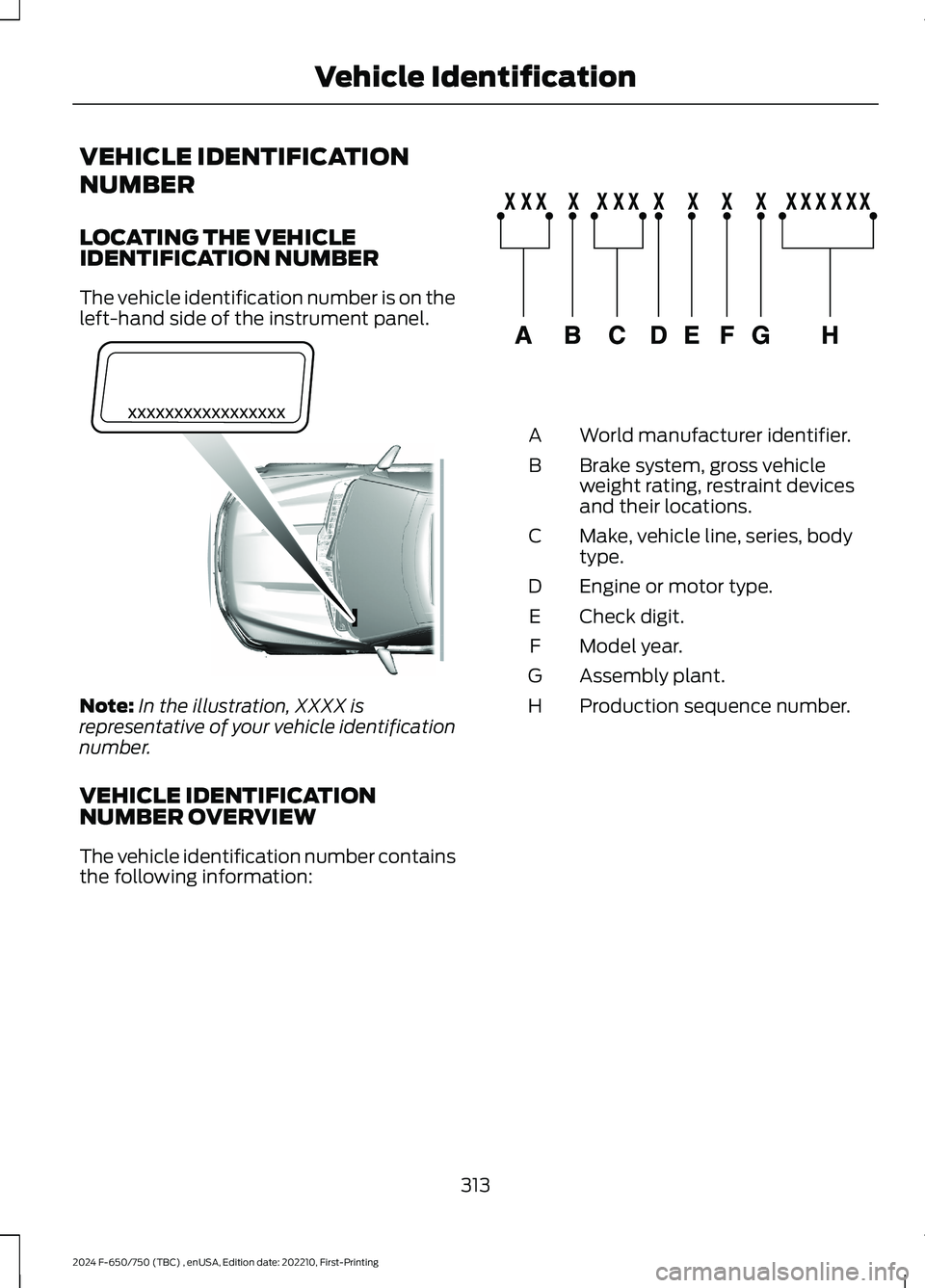2024 FORD F650/750 instrument panel
[x] Cancel search: instrument panelPage 258 of 386

Removal
1.Disconnect the fuel lines by squeezingthe connector tabs and pulling the linesstraight off.
2.Rotate the filter fully counterclockwiseuntil the peg is at the far end of the slot.
3.Pull the filter straight up from thebracket and discard the filter.
Installation
1.Install the new filter into the filterbracket. Turn the filter clockwise tolock it in place.
2.Reconnect the fuel lines.
3.Switch the ignition on for 30 secondsand then switch the ignition off.Repeat this operation six times in a rowto purge any trapped air from the fuelsystem.
ELECTRICAL SYSTEM
INSPECTION
Periodically inspect electrical connectorson the outside of the cab and on the engineand frame for corrosion and tightness.Exposed terminals, such as the fuel sender,cranking motor, alternator andfeed-through studs, should be cleaned andre-coated with a lubricant sealing greasesuch as Motorcraft Silicone Brake CaliperGrease and Dielectric Compound XG-3, orequivalent. This should include the groundcable connector for batteries, engine andcab as well as the jump-starting stud.
Accessory Feed Connections
Vehicle electrical systems are complex andoften include powertrain components,such as engine and transmission controls,instrument panels and ABS. While mostsystems operate on battery voltage (12volts), some systems can be as high as 90volts or as low as five volts. See theElectrical Circuit Diagram Manuals,available from your vehicle’s manufacturer,to make sure that any extra body lights andaccessory connections to circuits are bothappropriate and not overloaded. Do notmake modifications to any vehicle controlsystem without first contacting anauthorized dealer.
254
2024 F-650/750 (TBC) , enUSA, Edition date: 202210, First-PrintingMaintenanceE2262151 E22621423
Page 269 of 386

•Never wash or rinse the engine while itis hot or running; water in the runningengine may cause internal damage.
•Never wash or rinse any ignition coil,spark plug wire or spark plug well, orthe area in and around these locations.
•Cover the battery, power distributionbox, and air filter assembly to preventwater damage when cleaning theengine.
CLEANING THE WINDOWS AND
WIPER BLADES
Car wash chemicals and environmentalfallout can result in windshield and wiperblade contamination. Dirty windshield andwipers will result in poor windshield wiperoperation. Keep the windshield and wiperblades clean to maintain windshield wiperperformance.
To clean the windshield and wiper blades:
•Clean the windshield with anon-abrasive glass cleaner. Whencleaning the interior of the windshield,avoid getting any glass cleaner on theinstrument panel or door panels. Wipeany glass cleaner off these surfacesimmediately.
•For windshields contaminated withtree sap, chemicals, wax or bugs, cleanthe entire windshield using steel wool(no greater than 0000 grade) in acircular motion and rinse with water.
•Clean the wiper blades with isopropylrubbing alcohol or windshield washerconcentrate.
Note: Do not use razor blades or othersharp objects to clean or remove decalsfrom the inside of the heated rear window.The vehicle warranty does not coverdamage caused to the heated rear windowgrid lines.
CLEANING THE INTERIOR
WARNING: Do not use cleaningsolvents, bleach or dye on the vehicle'sseatbelts, as these actions may weakenthe belt webbing.
WARNING: On vehicles equippedwith seat-mounted airbags, do not usechemical solvents or strong detergents.Such products could contaminate theside airbag system and affectperformance of the side airbag in a crash.
For fabric, carpets, cloth seats and seatsequipped with side airbags:
•Remove dust and loose dirt with avacuum cleaner.
•Remove light stains and soil withMotorcraft Professional StrengthCarpet & Upholstery Cleaner.
•If grease or tar is present on thematerial, spot-clean the area first withMotorcraft Spot and Stain Remover. InCanada, use Motorcraft Multi-PurposeCleaner.
•If a ring forms on the fabric after spotcleaning, clean the entire areaimmediately (but do not oversaturate)or the ring will set.
•Do not use household cleaningproducts or glass cleaners, which canstain and discolor the fabric and affectthe flame retardant abilities of the seatmaterials.
Mirrors
Do not clean the housing or glass of anymirror with harsh abrasives, fuel or otherpetroleum or ammonia-based cleaningproducts.
265
2024 F-650/750 (TBC) , enUSA, Edition date: 202210, First-PrintingVehicle Care
Page 270 of 386

CLEANING THE INSTRUMENT
PANEL AND INSTRUMENT
CLUSTER LENS
WARNING: Do not use chemicalsolvents or strong detergents whencleaning the steering wheel orinstrument panel to avoid contaminationof the airbag system.
Note:Follow the same procedure ascleaning leather seats for cleaning leatherinstrument panels and leather interior trimsurfaces.
Clean the instrument panel and clusterlens with a clean, damp and soft cloth,then use a clean, dry and soft cloth to drythese areas.
•Avoid cleaners or polishes that increasethe gloss of the upper portion of theinstrument panel. The dull finish in thisarea helps protect you fromundesirable windshield reflection.
•Do not use any household cleaningproducts or glass cleaners as thesemay damage the finish of theinstrument panel, interior trim andcluster lens.
•Wash or wipe your hands clean if youhave been in contact with certainproducts such as insect repellent andsuntan lotion to avoid possible damageto the interior painted surfaces.
•Do not allow air fresheners and handsanitizers to spill onto interior surfaces.If a spill occurs, wipe off immediately.Your warranty may not cover thesedamages.
If a staining liquid like coffee or juice hasbeen spilled on the instrument panel or oninterior trim surfaces:
1.Wipe up spilled liquid using a clean,soft cloth as quickly as possible.
2.Use Motorcraft Premium Leather andVinyl Cleaner or a commerciallyavailable leather cleaning product forautomotive interiors. Test any cleaneror stain remover on an inconspicuousarea.
3.Alternatively, wipe the surface with aclean, soft cloth and a mild soap andwater solution. Dry the area with aclean, soft cloth.
4.If necessary, apply more soap andwater solution or cleaning product toa clean, soft cloth and press it onto thesoiled area. Allow this to set at roomtemperature for 30 minutes.
5.Remove the soaked cloth, then with aclean, damp cloth, use a rubbingmotion for 60 seconds on the soiledarea.
6.Dry the area with a clean, soft cloth.
REPAIRING MINOR PAINT
DAMAGE
We recommend that you contact anauthorized dealer to identify your vehiclecolor code. Authorized dealers havetouch-up paint to match your vehicle'scolor.
Before repairing minor paint damage, usea cleaner to remove particles such as birddroppings, tree sap, insect deposits, tarspots, road salt and industrial fallout.
Read the instructions before using cleaningproducts.
CLEANING THE WHEELS
1.Regularly clean them with a wheelcleaner. We recommend that you useFord approved wheel cleaner ifavailable.
2.Remove dirt and brake dust with asponge.
266
2024 F-650/750 (TBC) , enUSA, Edition date: 202210, First-PrintingVehicle Care
Page 300 of 386

BULB SPECIFICATION CHART
Replacement bulbs are specified in thechart below. Headlamp bulbs must bemarked with an authorized “D.O.T.” for
North America and an “E” for Europe toensure lamp performance, light brightnessand pattern and safe visibility. The correctbulbs will not damage the lamp assemblyor void the lamp assembly warranty andwill provide quality bulb illumination time.
Trade nameNumber of BulbsFunction
H13/90082Headlamps
W5W2Side marker lamp - front
3157NA2Park/Turn lamp- front
31572Tail/stop/turn/side marker
31572Reverse
31571License plate lamp
9121High-mount brake lamp
12V6W2Map lamp
5783Dome/reading lamps
28252Interior visor lamp
28252Mirror turn signal
28252Mirror clearance lamp
1945Front clearance lamps andfront identification lamps
Note:To replace instrument panel lights,see an authorized dealer.
ENGINE OIL CAPACITY AND
SPECIFICATION - 6.7L DIESEL
Use oil that meets the definedspecification and viscosity grade.
If you do not use oil that meets the definedspecification and viscosity grade, it couldresult in:
•Component damage that your vehiclewarranty does not cover.
•Longer engine cranking periods.
•Increased emission levels.
•Reduced vehicle performance.
•Reduced fuel economy.
296
2024 F-650/750 (TBC) , enUSA, Edition date: 202210, First-PrintingCapacities and Specifications
Page 317 of 386

VEHICLE IDENTIFICATION
NUMBER
LOCATING THE VEHICLEIDENTIFICATION NUMBER
The vehicle identification number is on theleft-hand side of the instrument panel.
Note:In the illustration, XXXX isrepresentative of your vehicle identificationnumber.
VEHICLE IDENTIFICATIONNUMBER OVERVIEW
The vehicle identification number containsthe following information:
World manufacturer identifier.A
Brake system, gross vehicleweight rating, restraint devicesand their locations.
B
Make, vehicle line, series, bodytype.C
Engine or motor type.D
Check digit.E
Model year.F
Assembly plant.G
Production sequence number.H
313
2024 F-650/750 (TBC) , enUSA, Edition date: 202210, First-PrintingVehicle IdentificationE311767 E142477
Page 325 of 386

AUXILIARY SWITCHES (IF
EQUIPPED)
For maximum vehicle performance, keepthe following information in mind whenadding accessories or equipment to yourvehicle:
•When adding accessories, equipment,passengers and luggage to yourvehicle, do not exceed the total weightcapacity of the vehicle or of the frontor rear axle (GVWR or GAWR asindicated on the Safety ComplianceCertification label). Ask an authorizeddealer for specific weight information.
•The Federal CommunicationsCommission (FCC) and CanadianRadio TelecommunicationsCommission (CRTC) regulate the useof mobile communications systemsequipped with radio transmitters, forexample, two-way radios, telephonesand theft alarms. Any such equipmentinstalled in your vehicle should complywith Federal CommunicationsCommission (FCC) and CanadianRadio TelecommunicationsCommission (CRTC) regulations, andshould be installed by an authorizeddealer.
•An authorized dealer needs to installmobile communications systems.Improper installation may harm theoperation of your vehicle, particularlyif the manufacturer did not design themobile communication systemspecifically for automotive use.
•If you or an authorized Ford dealer addany non-Ford electrical or electronicaccessories or components to yourvehicle, you may adversely affectbattery performance and durability. Inaddition, you may also adversely affectthe performance of other electricalsystems in the vehicle.
The auxiliary switch option packageprovides four switches, mounted in thecenter of the instrument panel. Theseswitches operate when the ignition is onor from battery power, depending on theswitchable power distribution box fuselocations #82 and #83. We recommend,however, that the engine remain runningto maintain battery charge when using theauxiliary switches for extended periods oftime or higher current draws.
Note:When your vehicle has a dieselengine, use the auxiliary switches only whilethe engine is running. The glow plugs alsodrain battery power when the ignition key isin the on position. Using the auxiliaryswitches, even for limited amounts of time,can cause your battery to drain quickly andprevent your vehicle from restarting.
When switched on, the auxiliary switchesprovide 20 amps or 40 amps of electricalbattery power for a variety of personal orcommercial uses.
The relays for the auxiliary switches are inthe power distribution box under the hoodby the right-hand fender. See yourauthorized dealer for service.
Each switch includes a power lead, ablunt-cut and sealed wire below theinstrument panel and to the left of thesteering column in the driver footwell area.
The power leads are coded as shown:
321
2024 F-650/750 (TBC) , enUSA, Edition date: 202210, First-PrintingAccessoriesE163431
Page 382 of 386

Changing the Wiper Blades.....................250Charging a Device..........................................98Checking the Wiper Blades.....................249Child Restraint and SeatbeltMaintenance.................................................45Child Restraint Positioning.........................35Child Safety......................................................25General Information............................................25Child Safety Locks.........................................36Cleaning Products.......................................262Cleaning the Engine...................................264Cleaning the Exterior..................................263Cleaning the Instrument Panel andInstrument Cluster Lens........................266Cleaning the Interior...................................265Cleaning the Wheels..................................266Cleaning the Windows and WiperBlades...........................................................265Climate Control..............................................86Cold Weather Precautions - 6.7LDiesel..............................................................187Cold Weather Precautions - 7.3L............188Connected Vehicle.......................................314Connected Vehicle –Troubleshooting.............................................314Connecting the Vehicle to a MobileNetwork.............................................................314Connected Vehicle Limitations...............314Connected Vehicle Requirements..........314Connected Vehicle –Troubleshooting.........................................314Connected Vehicle – Frequently AskedQuestions.........................................................314Connecting a Bluetooth® Device...........318Connecting the Vehicle to a MobileNetwork.........................................................314Connecting FordPass to the Modem..........314Enabling and Disabling the Modem............314What Is the Modem...........................................314Coolant CheckSee: Engine Coolant Check - 6.7LDiesel.................................................................235See: Engine Coolant Check - 7.3L................238Cooling System Capacity andSpecification - 6.7L Diesel......................301Cooling System Capacity andSpecification - 7.3L...................................302
Crash and Breakdown Information.......194Automatic Crash Shutoff................................195Cruise Control................................................158Cruise Control Indicators...........................159Cruise Control - Vehicles With: AdaptiveCruise Control...............................................52Cruise Control - Vehicles With: CruiseControl.............................................................52Customer Assistance.................................196Customer Information...............................345Radio Frequency CertificationLabels................................................................345
D
Data Recording..................................................11Daytime Running Lamps - Vehicles With:Configurable Daytime RunningLamps..............................................................57Daytime Running Lamps - Vehicles With:Daytime Running Lamps (DRL).............57Diesel Exhaust Fluid Capacity andSpecification...............................................307Diesel Particulate Filter..............................124Direction Indicators.......................................58Doors and Locks.............................................49Draining the Fuel Filter Water Trap - 6.7LDiesel.............................................................234Driver Alert......................................................166Driving Aids.....................................................166Driving Hints...................................................186Driving Through Water...............................189DRLSee: Daytime Running Lamps - Vehicles With:Configurable Daytime Running Lamps....57See: Daytime Running Lamps - Vehicles With:Daytime Running Lamps (DRL).................57
E
Economical Driving......................................187Electrical System Inspection...................254Electromagnetic Compatibility...............351Emission Law...................................................117End User License Agreement.................354Engine Block Heater....................................105Engine Coolant Check - 6.7LDiesel.............................................................235
378
2024 F-650/750 (TBC) , enUSA, Edition date: 202210, First-PrintingIndex
Page 384 of 386

Information Displays......................................71General Information.............................................71Information Messages..................................75Installing Child Restraints............................27Instrument Cluster........................................64Instrument Lighting Dimmer.....................56Instrument Panel............................................24Interior Lamps.................................................58Interior Mirror...................................................63Introduction.........................................................7
J
Jump Starting the Vehicle.........................190
K
Keys and Remote Controls........................46
L
Lane Keeping System..................................167Lighting Control..............................................55Lighting..............................................................55General Information............................................55Load Carrying.................................................178Load Limit........................................................178Locating the USB Ports...............................98Locking and Unlocking.................................49Lug NutsSee: Changing a Road Wheel........................287
M
Maintenance..................................................222General Information..........................................222Manual Climate Control..............................86Manual Seats....................................................91Message CenterSee: Information Displays..................................71MirrorsSee: Windows and Mirrors...............................60Mobile Communications Equipment.......17Motorcraft Parts - 6.7L Diesel.................293Motorcraft Parts - 7.3L...............................295
N
Noise Pollution Control................................22Normal Scheduled Maintenance..........330
O
Oil Change Indicator Reset......................229Oil CheckSee: Engine Oil Check.......................................227Opening and Closing the Hood..............223Ordering Additional Owner'sLiterature.....................................................200Overhead Console.......................................100
P
Parking Aids....................................................157Parking Brake.................................................140Passive Anti-Theft System..........................51PATSSee: Passive Anti-Theft System......................51Perchlorate........................................................15Playing Media From a USB Device.........318Playing Media Using the USB Port..........98Pneumatic Locking DifferentialIndicators......................................................138Pneumatic Locking Differential...............137Pneumatic Locking DifferentialPrecautions..................................................137Power Door LocksSee: Locking and Unlocking.............................49Power Seats.....................................................92Power Steering Fluid Check....................246Power Take-Off.............................................135Power Windows.............................................60Pre-Collision Assist - Vehicles With: AirBrakes.............................................................170Pre-Collision Assist - Vehicles With:Hydraulic Brakes.........................................173Protecting the Environment.......................22PunctureSee: Changing a Road Wheel........................287
380
2024 F-650/750 (TBC) , enUSA, Edition date: 202210, First-PrintingIndex